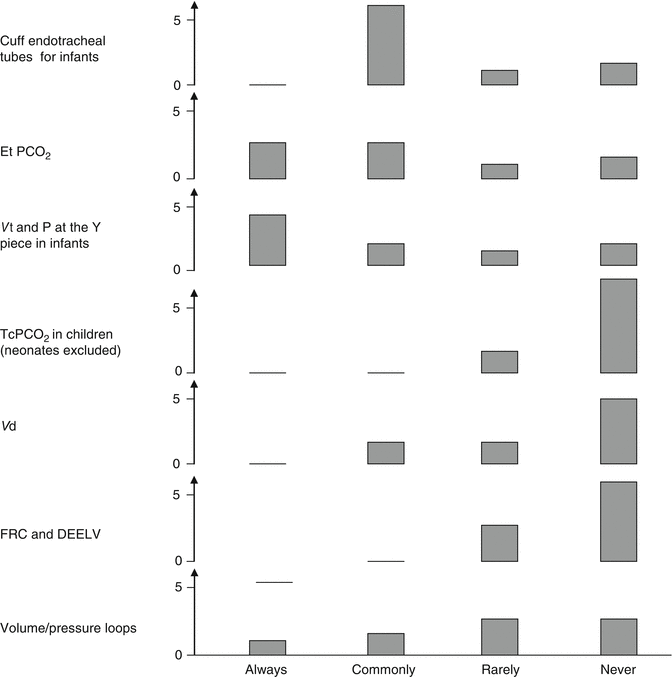Number of beds in PICU (median (min, max))
20 (7, 45)
Number of physicians in PICU (median (min, max))
7 (4,20)
Medical staff with pediatric critical care training (median %)
100
Neonatal cases, cardiac surgery included (median % (min, max))
10 (0, 35)
Fellowship program in pediatric critical care medicine (%)
63
24-h on-site pediatric ICU attending coverage (%)
37
The critical care nurse performs continuous bedside care, sometimes including the monitoring and modification of ventilation settings. Nurse-to-patient ratio is based on patient acuity, mechanically ventilated neonates and children usually have a 1:1 or 1:2 ratio. In a survey among PICUs across Canada and USA, nurses were involved in mechanical ventilation monitoring in 44 % of units and changed ventilator settings. In two-thirds, they set the inspired oxygen concentration, only.
Respiratory therapists are an integral part of bedside care in the PICU. They are trained in mechanical ventilation management. They take care of all ventilation aspects including operating and maintaining ventilators and managing pulmonary treatments (iNO, surfactant, inhaled medications). They adjust ventilator settings under the supervision of physicians. It is recommended by the American College of Critical Care Medicine and the Society of Critical Care Medicine to have in-house respiratory therapists available at all times. In practice, 90 % of PICUs have 24-h coverage (personal data), and some states mandate one respiratory therapist to a specific number of ventilated patients (usually between 4 and 6).
Physiotherapist performs chest manipulations, mobilization, incentive spirometry, and postural drainage. They usually do not take care of mechanical ventilation.
69.2 Recommended Equipment
In North America, PICUs and NICUs usually have approximately one conventional ventilator per bed. Nowadays, adult ICU ventilators are able to provide neonatal ventilation with similar performance, at least in term neonates, when compared to specific neonatal ventilators (Fontana et al. 2009). This reduces the need for different types of ventilators being available in a hospital and simplifies respiratory therapist education. Noninvasive ventilation is performed either with specific flow-generating devices (especially in neonates) or with noninvasive ventilation mode of conventional ventilators.
In addition to conventional ventilators, there are two to six high-frequency oscillatory ventilators per unit depending on the unit size. Although improvement of outcome with high-frequency oscillatory ventilation when compared to conventional ventilation is not clearly demonstrated, this mode is used frequently in neonatal and pediatric ARDS (Cools et al. 2009; Henderson-Smart et al. 2009; Randolph et al. 2003), usually the so-called rescue therapy.
The use of cuffed endotracheal tubes, and the measurement of end-tidal CO2, tidal volume, and airway pressures close to the Y-piece, is frequently done in clinical practice in North American units, but this is not the case for the measurement of dead space, residual capacity, and pulmonary volume at the end of expiration (Fig. 69.1).




